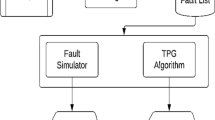Abstract
Due to the high complexity of the problem of generating test patterns for digital circuits Genetic Algorithms (GA) have been investigated as an alternative to deterministic algorithms for test generation. In this paper a Genetic Algorithm “GATPG” is presented for generating sequences of test vectors for sequential circuits. The aim is to produce compact test sequences that attain high fault coverage. Because of the constraints imposed on a GA by the peculiar characteristics of sequential circuits it is proposed here a nonuniform selection probability for crossover combined with individuals (test sequences) of variable length and a two-phase fitness function. For the evaluation of candidate test sequences is used a 3-valued fault simulator, allowing the test patterns to be applied on faulty circuits that start from an arbitrary (unknown) state. Experimental results with respect to the ISCAS’89 benchmarks are presented to show the viability of the proposed approach.
Preview
Unable to display preview. Download preview PDF.
Similar content being viewed by others
References
M. Abramovici, M. Breuer, A. Friedman: Digital Systems Testing and Testable Design. IEEE Press (1990).
T. M. Niermann, W. T. Cheng, and J. H. Patel: PROOFS: A fast, memory-efficient sequential circuit fault simulator. IEEE Trans. Computer-Aided Design (1992) 198–207.
T. M. Niermann and J. H. Patel: HITEC: A test generation package for sequential circuits. Proceedings of the European Conference on Design Automation (1991) 214–218.
F. Corno, P. Prineto, M. Rebaudengo, M. Sonza Reorda, R. Mosca: Advanced Techniques for GA-based sequential ATPGs. European Design & Test Conf. (1996).
E. M. Rudnick, J. H. Patel, G. S. Greenstein, and T. M. Niermann: Sequential circuit test generation in a genetic algorithm framework. Proc. Design Automation Conf. (1994) 698–704.
D. G. Saab, Y. G. Saab, J. A. Abraham: CRIS: A Test cultivation program for sequential VLSI circuits. ICCAD (1992) 216–219.
F. Corno, P. Prinetto, M. Rebaudengo, M. Sonza Reorda: GATTO: A Genetic Algorithm for Automatic Test Pattern Generation for Large Synchronous Sequential Circuits. IEEE Trans. on CAD, Vol. 15, No 8 (1996) 991–1000.
M. Hsiao, E. Rudnick, J. Patel: Sequential Circuit Test Generation Using Dynamic State Traversal. European Design & Test Conf. (1997) 22–28.
E. Rudnick, J. Patel: Combining deterministic and genetic approaches for sequential circuit test generation. DAC. (1995) 183–188.
M.H. Hsiao, E.M. Rudnick, J.H. Patel: Alternating strategies for sequential circuit atpg. European Design &Test Conf. (1996) 368–374.
D. E. Goldberg: Genetic Algorithms in Search, Optimization, and Machine Learning, Reading. MA: Addisson-Wesley (1989).
Zbigniew Michalewicz: Genetic Algorithms+ Data Structures=Evolution Programs. Springer (1996).
M. Hsiao, E. Rudnick, J. Patel: Application of Genetically Engineered Finite-State Machine Sequences to Sequential Circuit ATPG. IEEE Trans. CAD (March 1998) 239–254.
Pinaki Mazumder, Elizabeth M. Rudnick: Genetic Algorithms for VLSI Design, Layout & Test Automation. Prentice Hall (1999).
J. E. Beasly, P. C. Chu: A genetic algorithm for the set covering problem. European Journal of Operational Resaearch 94 (1996) 392–404.
F. Brglez, D. Bryan and K. Kozminski: Combinational profiles of sequential benchmark circuits. Int. Symposium on Circuits and Systems (1989) 1929–1934.
Author information
Authors and Affiliations
Editor information
Editors and Affiliations
Rights and permissions
Copyright information
© 2002 Springer-Verlag Berlin Heidelberg
About this paper
Cite this paper
Dimopoulos, M., Linardis, P. (2002). Using Non-uniform Crossover in Genetic Algorithm Methods to Speed up the Generation of Test Patterns for Sequential Circuits. In: Vlahavas, I.P., Spyropoulos, C.D. (eds) Methods and Applications of Artificial Intelligence. SETN 2002. Lecture Notes in Computer Science(), vol 2308. Springer, Berlin, Heidelberg. https://doi.org/10.1007/3-540-46014-4_43
Download citation
DOI: https://doi.org/10.1007/3-540-46014-4_43
Published:
Publisher Name: Springer, Berlin, Heidelberg
Print ISBN: 978-3-540-43472-6
Online ISBN: 978-3-540-46014-5
eBook Packages: Springer Book Archive




